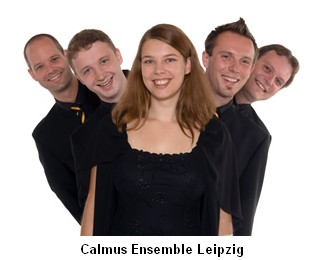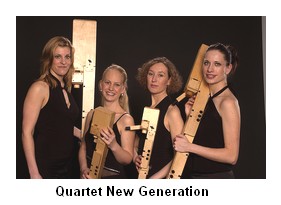
Reviews
Full disclosure: Many years ago, my choir gave me a nice wooden soprano recorder. The problem was that whenever I tried to teach myself how to play it, my kids would protest, “Nooooo, mama, not that! We’ll be good! We promise!” I can’t say I ever learned to play it, but it had its uses. Much later, I became an early music fan and, as a result, recorders and other period instruments spoke to me very differently. So it was on April 25 at Norfolk Academy’s lovely, intimate theater, when the five voices of the Calmus Ensemble joined forces with the four women of Quartet New Generation and their array of 40 recorders ranging from 6-inch sopranino instruments to a massive six-and-a-half footer. The Calmus Ensemble is comprised of five voices: soprano Anja Lipfert, countertenor Sebastian Krause, tenor Tobias Pöche, baritone Ludwig Böhme and bass Joe Roesler. Each is an accomplished soloist in his or her own right, but their clear voices, seamless blend and precise diction blended perfectly with the varied “voices” of QNG’s recorders, played by Susanne Fröhlich, Miako Klein, Heide Schwarz and Petra Wurz.
(Supertitles or texts printed in the program would have been a great help to audience members, since so much of the material was completely unfamiliar. Onomatopeia can take one only so far.)
It’s odd to think of a Mass being a parody of a secular song, but the Missa pro Victoria by Tomas Luis de Victoria (c. 1548-1611) incorporates the peculiar elements of Janequin’s song into a multiple choir Mass in which all five main movements reference the opening of La Guerre. It appears in his last book of Masses, dedicated to Prince Philip III. The Kyrie, Gloria and Credo were sung in the first half of the program, and the remaining Sanctus, Benedictus and Angus Dei closed the second half. One could just sit back and bask in Calmus’s pure sound and immaculate diction, and the interplay between instruments and voices. Early music groups have a problem: the composers have been dead for half a millennium, after all, and aren’t writing any new material. So, QNG commissioned Pulitzer-winning American composer Paul Moravec (b. 1957) to write a chamber chorale for their 2007-2008 season. Mortal Flesh is set on the 17th-century hymn tune PICARDY, whose best-known English text is “Let All Mortal Flesh Keep Silence.” The fantasy around that theme begins low and deep, and gradually becomes higher and brighter, while each of the four players must shift gracefully to the next-higher recorder, and the next, from bass recorders through tenor, alto, soprano and tiny sopranino instruments. There are modern dissonances, but as QNG’s website says, “It is exciting to see how the boundaries between Early and New Music start to vanish.” For the coronation of Eugene IV as Pope in 1431, Guillaume Dufay (1397-1474) wrote a very complex, rhythmically intricate work called Ecclesiae Militantis (The Church Militant); five voices sing five different texts — the high voices praising the new pope and a great hero and leader, while the tenor asks that the pope help the people, and bass and baritone repeat Ecce nomen Domini (Hear the name of the Lord) and Gabriel (the new pope’s birth name). It’s all very confusing; it would take several listenings to sort it all out, but it sounded terrific. Versa est in luctum by Spanish composer Alonso Lobo (1555-1617), marks the death of Philip II, king of Spain and son of the emperor Charles V. The text is not part of traditional Spanish liturgy—“My harp is turned to mourning and my music into the voice of those that weep. Spare me, Lord, for my days are nothing”—but it is very suitable for a requiem. The long, lovely vocal and instrumental lines leaned into one another; the breathtaking ending was perfectly tuned. The canon Vivat Carolus by the Lutheran composer Johann Walter (1496-1570) was written as a tribute to Maximilian II, the nephew of the emperor Charles V. Intoned by tenor recorder, with wonderful rhythms in the bass, the lower voices were wordless, with sopranino recorders and very light hand percussion, moving up to nice countertenor lines. Calmus and QNG decided for this special collaborative program to commission a new work by Moravec— a multi-movement work called Sacred Love Songs. This performance was its world premiere. Sung in English, the first movement was “Love Endures All Things” (1 Corinthians 13:7). Normally, in ensemble or choral singing, the singers stagger their breathing so the lines sound seamless. In this movement, however, the singers breathed together, and the audible inrush of breath became a subtly striking part of the music, accompanied by fast, high, birdlike sounds from the recorders. “A Prayer of St. Francis” was on the familiar text, “Make me an instrument of your peace,” by St. Francis of Assisi, with mixed recorders. “Set Me as a Seal” (Song of Solomon, 8:6) utilized and resolved modern dissonances; countertenor Sebastian Krause shone in this movement. An instrumental movement for the recorders began with lower “voices” and featured sopraninos in Messiaen-like birdsong. The final movement, “Greater Love Hath No Man” (John 15:13), was marked by beautiful vocal tuning and a reprise of the first movement’s text—absolutely lovely! The emperor Charles V was a powerful figure, which accounts for the numerous works composed for him. Constanzo Festa (1490-1545) composed Ecce advenit dominator (Behold, the ruler comes) for the emperor’s coronation in 1530. The ensembles separated for a double choir effect, with a singer and two recorders in a balcony box while the rest remained onstage. The final cadence was gorgeous. Another modern work was by Bavarian composer Wolfram Buchenberg (b.1962) — Lobe den Herrn, a setting of Psalm 104 — was commissioned by the Calmus Ensemble for their 10th anniversary concert in 2009. Its close, dense harmonies and close, high dissonances (moving together, which is quite difficult to do elegantly) evolved into odd, brisk rhythms with Hallelujahs echoing and ringing. The two ensembles took a simple German folk song, Der Mond ist aufgegangen (The moon is risen)—music by Johann Schulz (1790), text by Matthias Claudius (1773)— and brought out its lovely simplicity. In the second verse, the soprano led, while the male voices hummed exquisite harmonies. Printer Friendly Format Review Index
|
 The program, entitled “Blaze of Glory,” centered around music composed for great powers of the 15th and 16th centuries: popes, kings and emperors had the power (and the money) to commission the best composers to acclaim their achievements, their victories, their funerals. They began with a rousing Scaramella, by Josquin Des Prés (c.1450/55-1521), in which a knight is preparing to go forth and fight for his king, while the surrounding crowds cheer him on. (There is also a sly suggestion that his lance may symbolize something more.) Voices and instruments brought out the song’s bravado and humor.
The program, entitled “Blaze of Glory,” centered around music composed for great powers of the 15th and 16th centuries: popes, kings and emperors had the power (and the money) to commission the best composers to acclaim their achievements, their victories, their funerals. They began with a rousing Scaramella, by Josquin Des Prés (c.1450/55-1521), in which a knight is preparing to go forth and fight for his king, while the surrounding crowds cheer him on. (There is also a sly suggestion that his lance may symbolize something more.) Voices and instruments brought out the song’s bravado and humor. In La Guerre, by Clement Janequin (1485-1558), QNG’s deeper-voiced recorders brought out the long, solemn lines, while Calmus sang of the 1515 Battle of Marignan between the French, led by King François I, eventually vanquished the troops of the Duke of Milano. The second part of the song describes the battle itself and its many startling sounds. The vocal ensemble and the jaunty high recorders brought this to life with unusual vocal and instrumental “brrrs,” tremolos, odd whistles and squawks before the final declaration of “Victoire!”
In La Guerre, by Clement Janequin (1485-1558), QNG’s deeper-voiced recorders brought out the long, solemn lines, while Calmus sang of the 1515 Battle of Marignan between the French, led by King François I, eventually vanquished the troops of the Duke of Milano. The second part of the song describes the battle itself and its many startling sounds. The vocal ensemble and the jaunty high recorders brought this to life with unusual vocal and instrumental “brrrs,” tremolos, odd whistles and squawks before the final declaration of “Victoire!”